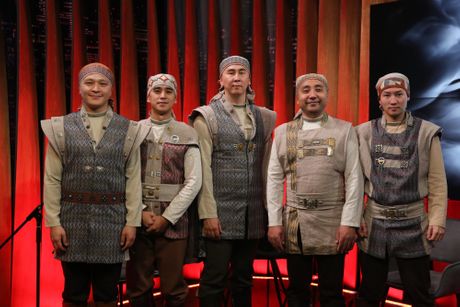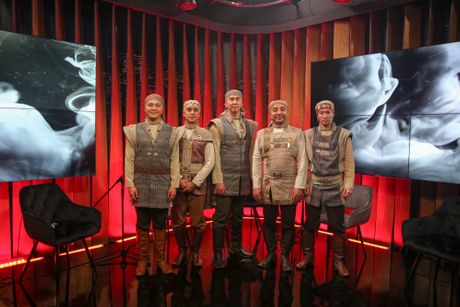We hosted Kazakhstan's Turan ensemble: They told Telegraf.rs about music, importance of tradition, Serbia...
One of the most popular folk music bands of Kazakhstan, the Turan ensemble, were in Serbia on October 30 and held a concert at the Kolarac Foundation in Belgrade.
Before their performance, the members of this band visited the Telegraf.rs portal's premises, and we talked with them about their music, Kazakhstan, and their impressions of Serbia.
- What are Turan's songs about? Are they traditional motifs, motifs from everyday life?
The creativity of the Turan ethno-folk ensemble has its roots in the distant past. We are talking about history, culture, the spirituality of our ancestors, who lived in the distant past, in the era of the Massagets, Sakas, and Huns. As you can see, all our... not only playing, our instruments, costumes, everything speaks of those ancient times when our ancestors, nomads, lived in the endless steppes. Our music evokes the symbolism of our ancestors, their culture. It also talks about some events from the lives of our ancestors.
Now we have performed three compositions for you. The first was "The White Swan" (by Nurgis Tilendiev). It is the totemic animal of our ancestors, which symbolizes not only love, both among the Kazakh people and all the peoples of the Turkic group, it is a symbol of purity, spirituality, sacredness.
The second composition is called "Kara Zhorga," it is an ancient dance of our ancestors, in the version of the Turan ensemble.
This composition, as you could hear, evokes various ways in which a horse walks, you could hear the sound of the hooves, the sounds of some natural phenomena.
The third composition tells about the history of the Kazakh people, about its origin, about what they had to live through and how they reached today's independence. In short, that's it.

- How important is tradition in your music and how important is the contemporary time? How to combine these two concepts?
In the Kazakh tradition... ensembles are a recent phenomenon, earlier there were authentic solo performances, ensembles came later.
In our Turan ensemble, we use a syncretic genre - it could be a song, a recital, various epic motifs, it can also be a dance. We combined several genres into one. With this flow, this style of playing, starting in 2008, relying on other ensembles, we created a new style.
As you have noticed, each of us in the ensemble plays several instruments. As a whole, our compositions, in terms of percentage, are 70% ours, and 30% arrangements of music by folk composers, and so on.
Of course, we also use a modern playing style, that's already an interpretation, improvisation, everything started from there.
- Can you describe your instruments? What are their names and what is their history?
Kazakh folk instruments are divided into five basic types: - plucked, for example this dombra, among the Kazakh people there are over 24 types of this instrument. Here, for example, is the shankobyz dombra, children played on it, a love if music is instilled in them in that way.
Furthermore, we have string instruments, that is this kobyz, many others. Now there is a modern prima-kobyz, there are many varieties... then we have a zhetygen. Earlier it had 7 strings, this modern one has 23 strings. Horse hair was used in the past, now it is different.
We have percussion instruments, such as dongira - a shaman drum, the skin is stretched over it, then kuntayak, the "sun-headed man," then taytuyak, susygr - we added that to the ensemble later. We have mouth instruments - shankobyz, sybyzgy, sazsyrnay and so on.
That's that.
It should be noted that our folk musical instruments are made, as you can see, from natural materials. We have wood, base material, leather, horse hair, metal inserts. A sheep's intestines used to be stretched on the dombra. Natural materials are always used. Here, it's kid skin. And one more thing, among the Kazakh people, instruments were considered sacred. Sometimes they were treated like a living being. They were trying to preserve the soul, or the spirit of an animal or the tree itself. For example when an instrument was made, it was made from a single piece of wood.
Many instruments are shamanic, they were used to heal people and predict the future. One of the colorful examples is the kobyz, inside you can see small mirrors, which is typical of shamanism.
Through those mirrors, the shaman who plays that instrument can enter the "other" world, and thus restore a person's health, i.e. heal, or predict the future.
We have a lot such instruments that were used in rituals before.

- What is interesting for us in Serbia is what's known as throat singing. We know a little about throat singing, about groups like Huun Huur Tu, Yat-Kha, Albert Kuvezin... How deep-rooted is the tradition of throat singing in Kazakhstan and to what extent does it differ from Mongolian, Tuvin and other schools of throat singing?
The Kazakh people have been one of the ethnicities belonging to the Turkic group of peoples since time immemorial. That used to be called the Great Turanian Civilization. That's why many traditions, many instruments, many rituals are similar. This also applies to throat singing. In Kazakhstan, unfortunately, many instruments have not yet been restored, many have fallen into oblivion, but today a lot of scientists, musicians, dealing with the subject, are bringing many instruments back. We currently have over 30 musical instruments, which we use in the ensemble.
We have also renewed a method of interpretation - throat singing. The Kazakh people have preserved a unique style of throat singing that is used in the Karaganda region, in the "hoomii" style, we sing epic songs in that style.
We use several types of throat singing in our ensemble. In Turkic countries there is a myth, a myth about a sacred tree, which permeates all three worlds. The three worlds are: the lower world - the world of dead souls, the middle world, where the tree is, the root is in the ground and the tree is above the ground. The tree signifies living people, living beings, and also the canopy, which connects with the upper world, the world of the aruah, the holy spirits. Each of these worlds has its totem animals.
All three worlds can also be represented with throat singing.
Now we will demonstrate to you all three types, divided by those worlds.
The first type is called kargira - the lower world.
The second world, that is the world of the living - humi.
And the third world, that is the world of the holy aruahs.
- Is this your first time in Serbia? How do you like our country?
We have visited many countries. And as for the Balkans, we were in Bosnia, Croatia, Moldova before, now we are in Serbia. We are in Serbia for the first time. We had an excursion yesterday, we really liked it. Precisely this symbiosis of multiple cultures, we felt a kind of balance between the past and the present, and this can be seen in the city's architecture, that atmosphere. Today we will try 100% to gift our music to the Serbian audience.

- If I were to travel to Kazakhstan, what would you recommend I should see and visit?
There is a lot to see in Kazakhstan. We have deserts and mountains, forests and lakes. You can experience different seasons. Everything that exists in the world, you can see it in one in Kazakhstan, it is a vast territory, rich in natural resources, rich in culture and tradition, so I am sure you would like Kazakhstan very much.
(Telegraf.rs)
Video: Treći dan sabora: Građani mogu da se informišu o pokretu, povoljnim kreditima za mlade
Telegraf.rs zadržava sva prava nad sadržajem. Za preuzimanje sadržaja pogledajte uputstva na stranici Uslovi korišćenja.

